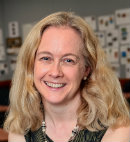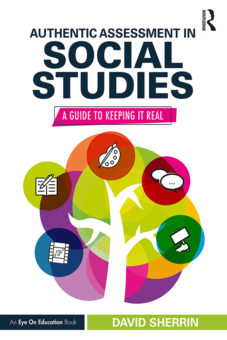Keeping Assessment in Social Studies Real
Authentic Assessment in Social Studies: A Guide to Keeping It Real
By David Sherrin
(Routledge/Eye On Education, 2020 – Learn more)

Practical, touching and funny, David Sherrin’s Authentic Assessment in Social Studies: A Guide to Keeping It Real offers a multitude of innovative approaches while reminding us that student potential lies at the heart of everything we do as teachers.
If we understand and appreciate the diversity of students’ talents, this book argues, we can recognize the potential of all kids, not just those who do well on conventional assessments.

As just one example, his Magical Camera technique has already inspired me to change how I ask students to introduce their research papers in the future. Sherrin says:
“The Magical Camera technique asks writers to imagine the most powerful or gripping moment of the historical story that serves as the background or context of their piece… Now, imagine that you the writer were there at that moment, camera in hand. You took one picture. But this is a ‘Magical Camera’ and it records every sense of that instant… Describe all that the camera captures in minute detail.”
Beyond sharpening students’ prose, the Magical Camera hook “also makes the writing process joyful for the author.”
Written, Creative, Artistic and Civic Action Assessments
Even a glance at the detailed table of contents can invoke joy at the choices Sherrin offers.
Part 1 covers Authentic Assessment, along with answers to commonly asked questions, such as “What if JADE [Joy, Authenticity, Dynamism, and Effectiveness] authentic assessments don’t seem as rigorous as tests or formal writing?” and “”What if I’m not good at art and other JADE assessments? How can I grade students at it?”
Part 2 gets more specific, with many tricks for helping students on Written Assessments:
- Formal Essay, including writing body paragraphs and quotations vs. paraphrasing;
- Research Papers, including finding journal articles and outlining and writing the paper;
- Creative Writing, including poetry and letters to historical characters.
Part 3 covers a swath of Creative and Artistic Assessments:
- Oral Communication, including oral history interviews and student-led lessons;
- Art, including fashion design, monuments and graphic histories;
- Digital History, including testimonials, documentary and newscasts.
And Part 4 tackles Civic Action Assessments, featuring projects such as organizing a human rights conference and applying design thinking to local issues.
A Book Designed for Action
To help translate the book to action, each chapter includes a chart at the beginning that suggests: “After reading the chapter, use the following chart as a plan to ‘keep the learning real.’” A question in the Formal Essay chapter, for example, asks, “How will you first teach students to hook their reader in their introductions?” and nearly every chapter asks where teachers could integrate various topics, such as oral communication, civics and art, in the year’s units.
In addition, questions about the ethics of history arise frequently throughout the book, influenced by Sherrin’s having taught at the Facing History School and other schools that have given him freedom to explore the deep issues history can elicit.
Tip After Tip
Throughout the book I underlined strategies that lit my creative brain, such as a Bill of Rights monument, a “What the Constitution Means to Me” testimonial, and a RICE acronym on writing strong conclusions (Restate, Importance, Connections, Expanding).
Mostly, this book just made me want to get in the classroom and teach! It reminded me how enjoyable it can be to finish a unit by putting students’ creativity center stage.
As Sherrin asserts:
“We can simultaneously evaluate students’ learning and allow them to have fun. Painting, civic action, museum galleries, digital history, dance, leading lessons, oral communication and even inquiry research papers can serve as play for students. The fun does not need to end with assessments; this is when the fun can really begin.”
Sarah J. Cooper (@sarahjcooper01) teaches eighth-grade U.S. history and is Assistant Head for Academic Life at Flintridge Preparatory School in La Canada, California, where she has also taught English Language Arts. Sarah is the author of Making History Mine (Stenhouse, 2009) and Creating Citizens: Teaching Civics and Current Events in the History Classroom (Routledge, 2017). She presents at conferences and writes for a variety of educational sites. You can find all of Sarah’s writing at sarahjcooper.com.






























